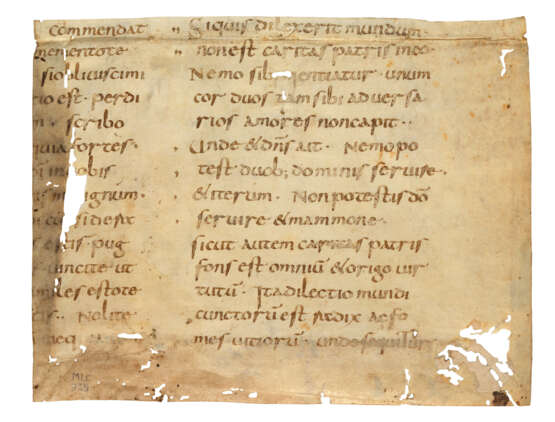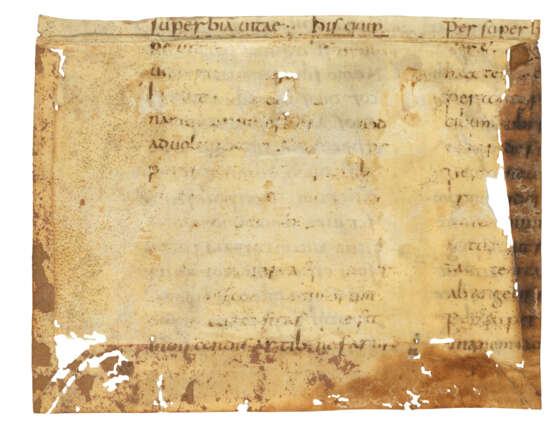ID 869400
Lot 7 | Bede (673-735)
Estimate value
£ 4 000 – 6 000
Fragment from Bede, Super Epistolas Catholicas in Latin, manuscript on vellum [Italy, perhaps Rome, 10th century]
A fine example of a 10th-century Italian variant of Caroline minuscule script
c.152 × 195mm. 2 columns of 14 lines, in Romanesca minuscule, the text comprising Bede’s commentary on 1 John 2:14–16 ('commendat [hoc et repetit] […] inanem iac[tantiam]') (recovered from use as a pastedown in an octavo-sized volume with a tanned leather binding, with consequent stains and damage, one side very clean and legible, the other only partially legible).
Provenance:
Colker MS 325; acquired in 1984 from Quaritch.
Script:
The script is slanted to the right with very rounded and somewhat flattened aspect; final minims of ‘l’, ‘m’, ‘n’, ‘t’, ‘u’, extend slightly to the right, ‘oc-a’ ligature after ‘r’, very flattened descender to ‘d’, lower bowl of ‘g’ slightly open, upper stroke of ‘r’ is extended and curved, majuscule ‘t’. There is very limited use of ligatures (‘st’) and abbreviations. Colker dated this handsome specimen to the 9th century and described it as Farfa minuscule, but ‘Farfa type' or romanesca rightly belongs to the 11th century (cf. lot 23), with its 9th-century predecessor called Romanesca or Roman Caroline. There are extremely few examples from the 9th century – and in any case this appears to be a more transitional script between the two; it is likely therefore to be 10th-century, the presence of ‘oc-a’ being the oldest dating feature. The oldest witness of ‘Romanesca’ is dated c. 938 (Vatican, BAV, S. Maria Maggiore 104).
| Genre: | Religious genre |
|---|---|
| Place of origin: | Italy |
| Auction house category: | Medieval & renaissance manuscripts |
| Genre: | Religious genre |
|---|---|
| Place of origin: | Italy |
| Auction house category: | Medieval & renaissance manuscripts |
| Address of auction |
CHRISTIE'S 8 King Street, St. James's SW1Y 6QT London United Kingdom | |
|---|---|---|
| Preview |
| |
| Phone | +44 (0)20 7839 9060 | |
| Buyer Premium | see on Website | |
| Conditions of purchase | Conditions of purchase |




